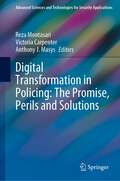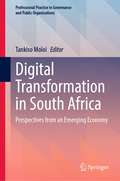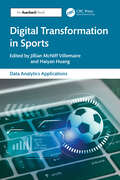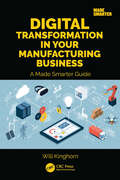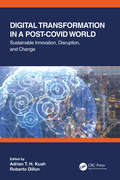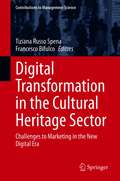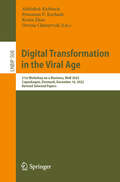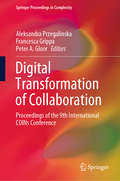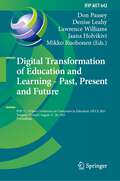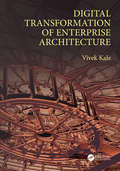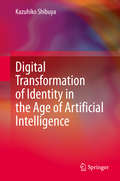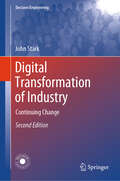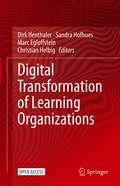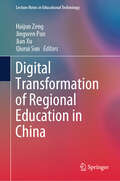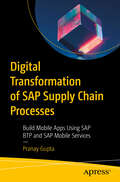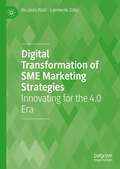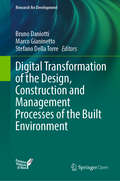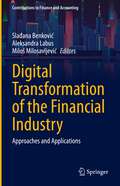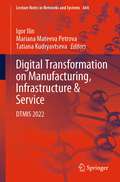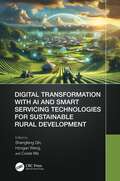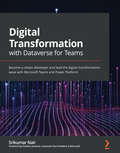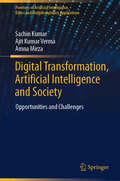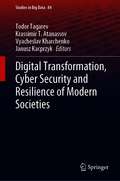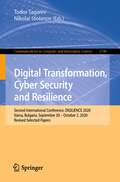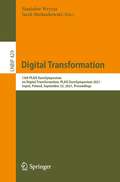- Table View
- List View
Digital Transformation in Policing: The Promise, Perils and Solutions (Advanced Sciences and Technologies for Security Applications)
by Anthony J. Masys Reza Montasari Victoria CarpenterThis book shares essential insights into how the social sciences and technology could foster new advances in managing the complexity inherent to the criminal and digital policing landscape. Said landscape is both dynamic and intricate, emanating as it does from crimes that are both persistent and transnational. Globalization, human and drug trafficking, cybercrime, terrorism, and other forms of transnational crime can have significant impacts on societies around the world. This necessitates a reassessment of what crime, national security and policing mean. Recent global events such as human and drug trafficking, the COVID-19 pandemic, violent protests, cyber threats and terrorist activities underscore the vulnerabilities of our current security and digital policing posture.This book presents concepts, theories and digital policing applications, offering a comprehensive analysis of current and emerging trends in digital policing. Pursuing an evidence-based approach, it offers an extraordinarily perceptive and detailed view of issues and solutions regarding the crime and digital policing landscape. To this end, it highlights current technological and methodological solutions as well as advances concerning integrated computational and analytical solutions deployed in digital policing. It also provides a comprehensive analysis of the technical, ethical, legal, privacy and civil liberty challenges stemming from the aforementioned advances in the field of digital policing; and accordingly, offers detailed recommendations supporting the design and implementation of best practices including technical, ethical and legal approaches when conducting digital policing. The research gathered here fits well into the larger body of work on various aspects of AI, cybersecurity, national security, digital forensics, cyberterrorism, ethics, human rights, cybercrime and law. It provides a valuable reference for law enforcement, policymakers, cybersecurity experts, digital forensic practitioners, researchers, graduates and advanced undergraduates, and other stakeholders with an interest in counter-terrorism. In addition to this target audience, it offers a valuable tool for lawyers, criminologist and technology enthusiasts.
Digital Transformation in South Africa: Perspectives from an Emerging Economy (Professional Practice in Governance and Public Organizations)
by Tankiso MoloiThis book examines the adoption of digital technologies in different sectors in South Africa. The authors investigate how digital innovation impacts development in various areas in the public and private sectors. Chapters in the book cover digital transformation in authorities and government bodies and how this transforms governance, this includes digital transformation for good governance in the public sector, tax authorities, local government, and traditional authorities. The second set of chapters emphasizes the digital transformation of business corporations, such as digital transformation lessons for small businesses, digital transformation of finance, and the banking sector. Other chapters delve into enterprise processes such as auditing, corporate reporting, good corporate reputation, enterprise risk management, and marketing environment. The book will appeal to an audience of scholars and professionals wanting to understand more about the role of digital transformation in emerging economies and how innovation influences economic growth.
Digital Transformation in Sports (Data Analytics Applications)
by Haiyan Huang Jillian McNiff VillemaireThe sports industry is one of the most robust and competitive sectors in the world. Over the last decade, the integration of technology into sports has dramatically transformed the dynamics of how the sports industry operates. Sports analytics (i.e., the integration of data science and sports) is at the forefront of this digital transformation. Sports analytics encompasses the applications of innovative technologies and advanced analytical techniques to assess and enhance performance of players and teams, improve decision-making across diverse aspects, and bolster competitive advantages and strategies.Digital Transformation in Sports explores the key driving forces and emerging trends that are fueling the digital transformation of the sports industry. It presents a collection of chapters that delve into state-of-the-art research and real-world applications of sports analytics, providing a diverse perspective on its transformative impact across different sports sectors. It showcases how advanced technologies such as the Internet of Things (IoT), machine learning (ML), and artificial intelligence (AI) are revolutionizing player performance, strategic decision-making, fan engagement, and operational efficiency. For example, by utilizing sensors, wearable technologies, tracking devices, and 5G networks, IoT technologies can collect an unprecedented amount of data in real time and enable the near-instantaneous transmission of this data to the centralized platforms for analysis. Sophisticated analytics powered by AI and ML enable the extraction of actionable insights from this raw data, transforming it into valuable intelligence that drives better decision-making.By offering a bridge between theoretical frameworks and practical applications, this book demonstrates how such concepts as technology acceptance theories inform the successful implementation and adoption of analytics solutions. By drawing upon interdisciplinary insights, the chapters provide valuable tools and frameworks for researchers, analysts, practitioners, and stakeholders, delivering actionable guidance to harness the full potential of analytics in the rapidly evolving sports landscape.
Digital Transformation in Your Manufacturing Business: A Made Smarter Guide
by Will KinghornAre you a manufacturing leader and unsure of which technology can help grow your business? Have you heard about 3D printing, Industry 4.0, robots, or artificial intelligence but don’t know how they can be used in manufacturing?This book gives a clear and practical guide to manufacturing technologies, providing examples of how they’re used, as well as the tools and techniques you’ll need to get started. Each technology is covered in a brief and simple way allowing you to understand it quickly and decide if it’s worth investigating for your business.In addition to this book, the online resources will provide you with templates and examples to help you get started. At every stage there are suggestions for the key terms you will need to find more information appropriate to your industry.This isn’t just about technology, it’s a roadmap for your digital transformation. Start with guidance on setting your company’s vision and direction, to getting the people in your business engaged and ready to adopt technology. Move on to exploring each of the technologies, and the tools and techniques you’ll find useful along the way. Finally, connect the technologies with the tools that are appropriate, and look at common issues in manufacturing businesses and how these can be resolved.Get started with making informed decisions, embracing technologies, and transforming your business.
Digital Transformation in a Post-Covid World: Sustainable Innovation, Disruption, and Change
by Roberto Dillon Adrian T. H. KuahThis book explores the innovations, disruptions and changes that are required to adapt in a fast-evolving landscape due to the extraordinary circumstances triggered by the COVID-19 pandemic. Recognized experts from around the world share their research and professional experience on how the working environment, as well as the world around them, have changed due to the pandemic. Chapters consider how different fields across technology and business have been affected by this new, dramatic scenario and the drastic consequences that the pandemic had on them. With diverse contributions stemming from public health, technology strategies, urban planning and sociology to sustainable management, this volume is articulated into four distinct but complementary sections of People, Process, Planet, and Prosperity influencing the post-COVID world. This book will be of great interest to those in the fields of computer science and information technology, as well as those studying the impact and effects that COVID-19 is having on society.
Digital Transformation in the Cultural Heritage Sector: Challenges to Marketing in the New Digital Era (Contributions to Management Science)
by Tiziana Russo Spena Francesco BifulcoThis book devises an alternative conceptual framework to understand digital transformation in the cultural heritage sector. It achieves this by placing a high importance on the role of technology in the strategic process of modeling and developing cultural services in the digital era. The focus is on how marketing activities and customer processes are being transformed by digital technologies to create better value, which can also be communicated to customers through an engaged and personalized approach. Much of the digital debate in cultural heritage is still in infancy. Some existing studies are anecdotal and often developed within the domain of established research streams, including studies with some technological aspects addressed partially and from an episodic or periodic perspective. Moreover, the critical changes that have emerged in the cultural management landscape are yet to be highlighted. This book fills that gap and provides a perspective on the cultural heritage sector, which uses the new social and technology landscape to describe the digital transformation in cultural heritage sectors. The authors highlight an inclusive perspective that addresses marketing strategy in the digital era as a proactive, technology-enabled process by which firms collaborate with customers to jointly create, communicate, deliver, and sustain experience and value co-creation.
Digital Transformation in the Viral Age: 21st Workshop on e-Business, WeB 2022, Copenhagen, Denmark, December 10, 2022, Revised Selected Papers (Lecture Notes in Business Information Processing #508)
by Abhishek Kathuria Kexin Zhao Prasanna P. Karhade Devina ChaturvediThis book constitutes revised selected papers from the 21st Workshop on e-Business, WeB 2022, which took place virtually on December 10, 2022. The purpose of WeB is to provide a forum for researchers and practitioners to discuss findings, novel ideas, and lessons learned to address major challenges and map out the future directions for e-Business. The WeB 2022 theme was “Digital Transformation in the Viral Age”. The 8 full papers included in this volume were carefully reviewed and selected from a total of 31 submissions. They focus on issues, opportunities, and solutions related to e-business, digital transformation, and IT-enabled recovery in the viral age.
Digital Transformation of Collaboration: Proceedings of the 9th International COINs Conference (Springer Proceedings in Complexity)
by Peter A. Gloor Francesca Grippa Aleksandra PrzegalinskaThis proceedings is focused on the emerging concept of Collaborative Innovation Networks (COINs). COINs are at the core of collaborative knowledge networks, distributed communities taking advantage of the wide connectivity and the support of communication technologies, spanning beyond the organizational perimeter of companies on a global scale. The book presents the refereed conference papers from the 7th International Conference on COINs, October 8-9, 2019, in Warsaw, Poland. It includes papers for both application areas of COINs, (1) optimizing organizational creativity and performance, and (2) discovering and predicting new trends by identifying COINs on the Web through online social media analysis. Papers at COINs19 combine a wide range of interdisciplinary fields such as social network analysis, group dynamics, design and visualization, information systems and the psychology and sociality of collaboration, and intercultural analysis through the lens of online social media. They will cover most recent advances in areas from leadership and collaboration, trend prediction and data mining, to social competence and Internet communication.
Digital Transformation of Education and Learning - Past, Present and Future: IFIP TC 3 Open Conference on Computers in Education, OCCE 2021, Tampere, Finland, August 17–20, 2021, Proceedings (IFIP Advances in Information and Communication Technology #642)
by Don Passey Mikko Ruohonen Lawrence Williams Denise Leahy Jaana HolvikiviThis book constitutes the refereed post-conference proceedings of the IFIP TC 3 Open Conference on Computers in Education, OCCE 2021, held in Tampere, Finland, in August 2021. The 22 full papers and 2 short papers included in this volume were carefully reviewed and selected from 44 submissions. The papers discuss key emerging topics and evolving practices in the area of educational computing research. They are organized in the following topical sections: Digital education across educational institutions; National policies and plans for digital competence; Learning with digital technologies; and Management issues.
Digital Transformation of Enterprise Architecture
by Vivek Kale"In this book, Vivek Kale makes an important contribution to the theory and practice of enterprise architecture … this book captures the breadth and depth of information that a modern enterprise architecture must address to effectively support an agile enterprise. This book should have a place in every practicing architect's library." —John D. McDowall, Author of Complex Enterprise Architecture Digital Transformation of Enterprise Architecture is the first book to propose Enterprise Architecture (EA) as the most important element (after Business Models) for digital transformation of enterprises. This book makes digital transformation more tangible by showing the rationale and typical technologies associated with it, and these technologies in turn reveal the essence of digital transformation. This book would be useful for analysts, designers and developers of future-ready agile application systems. This book proposes that it is the perennial quest for interoperability & portability, scalability, availability, etc., that has directed and driven the evolution of the IT/IS industry in the past 50 years. It is this very quest that has led to the emergence of technologies like service-oriented, cloud, and big data computing. In addition to the conventional attributes of EA like interoperability, scalability and availability, this book identifies additional attributes of mobility, ubiquity, security, analyticity, and usability. This pragmatic book: Identifies three parts effort for any digital transformation: Business Models, Enterprise Architectures and Enterprise Processes. Describes eight attributes of EA: interoperability, scalability, availability, mobility, ubiquity, security, analyticity, and usability. Explains the corresponding technologies of service-oriented, cloud, big data, context-aware, Internet of Things (IoT), blockchain, soft, and interactive computing. Briefs on auxiliary technologies like integration, virtualization, replication, spatio-temporal databases, embedded systems, cryptography, data mining, and interactive interfaces that are essential for digital transformation of enterprise architecture. Introduces interactive interfaces like voice, gaze, gesture and 3D interfaces. Provides an overview of blockchain computing, soft computing, and customer interaction systems. Digital Transformation of Enterprise Architecture proposes that to withstand the disruptive digital storms of the future, enterprises must bring about digital transformation, i.e. a transformation that affects an exponential change (amplification or attenuation) in any aspect of the constituent attributes of EA. It proposes that each of these technologies (service-oriented, cloud, big data, context-aware, IoT, blockchain, soft, and interactive computing) bring about digital transformation of the corresponding EA attribute viz. interoperability, scalability, availability, mobility, ubiquity, security, analyticity, and usability.
Digital Transformation of Identity in the Age of Artificial Intelligence
by Kazuhiko ShibuyaThis book examines the digital transformation of identity in the age of artificial intelligence. It articulates the nature of identity of human beings, based on cutting-edge knowledge in the field of AI and big-data sciences, and discusses identity by drawing on comprehensive investigations in digital social sciences and exploring wider disciplines related to philosophy, ethics, sociology, STS, computer sciences, engineering, and medical sciences. Reviewing contemporary conditions proliferated by advanced technological trends and unveiling social mechanisms of human identity, this book appeals to undergraduate and graduate students as well as academic researchers.
Digital Transformation of Industry: Continuing Change (Decision Engineering)
by John StarkThis graduate textbook is focused on digital transformation. It answers key questions regarding: which technologies can be used to transform an organisation, which activities within an organisation can be transformed, and what the aim of digital transformation should be. Now fully updated and expanded in this second edition, the content is divided into three main parts, the first of which offers an introduction to the topic, highlights fundamental examples of digital transformation, defines the terminology, and enables readers to quickly understand the main components of digital transformation. The second part of the book addresses examples of digital transformation from several industries, including: government; finance; health; manufacturing; and education. The third and final section of the book describes the activities and processes within a typical digital transformation programme. The pedagogical approach to the process makes the book beneficial to both students who have never been involved in such a programme and practitioners who plan to implement digital transformation in their organisation.
Digital Transformation of Learning Organizations
by Dirk Ifenthaler Sandra Hofhues Marc Egloffstein Christian HelbigThis open access volume provides insight into how organizations change through the adoption of digital technologies. Opportunities and challenges for individuals as well as the organization are addressed. It features four major themes: 1. Current research exploring the theoretical underpinnings of digital transformation of organizations. 2. Insights into available digital technologies as well as organizational requirements for technology adoption. 3. Issues and challenges for designing and implementing digital transformation in learning organizations. 4. Case studies, empirical research findings, and examples from organizations which successfully adopted digital workplace learning.
Digital Transformation of Regional Education in China (Lecture Notes in Educational Technology)
by Jian Xu Haijun Zeng Jingwen Pan Qiurui SunThis book presents the best practices of smart education in different regions across China. Each chapter addresses one or more of the following topics: smart learning environments, new education and teaching models, teaching platforms and digital tool applications, teacher professional development, smart education evaluation, education governance, and education digitization. This edited collection promotes digital integration and innovative development of education, improves regional education levels, and ultimately forms a new model to support and lead the modernization of education in China.
Digital Transformation of SAP Supply Chain Processes: Build Mobile Apps Using SAP BTP and SAP Mobile Services
by Pranay GuptaTake a high-level tour of SAP oDATA integrations with frontend technologies like Angular using the SAP Mobile Services Platform. This book will give you a different perspective on executing SAP transactions on iOS using Angular instead of SAP-provided Fiori-based applications. You’ll start by learning about SAP supply chain processes such as Goods Receipt, Transfer Posting, Goods Issue, and Inventory Search. You’ll then move on to understanding the thought process involved in integrating SAP's backend (SAP ECC) with Angular iOS app using SAP Mobile Services running on SAP BTP. All this will serve as a guide tailored to SAP functional and technical consultants actively engaged in client-facing roles. You’ll follow a roadmap for modernizing and streamlining supply chain operations by leveraging Angular iOS apps. Digital Transformation of SAP Supply Chain Processes provides the essential tools for businesses looking to stay competitive in today's technology-driven landscape. What You Will Learn Study the fundamental procedures to set up the Authorization Endpoint, Token Endpoint, and base URL within SAP Mobile Services.Manage attachments in mobile applications and store them in an external content repository. Gain proficiency in testing OData services using the POSTMAN API client with OAuth protocol.Acquire knowledge about the JSON messages, CORS protocol, and X-CSRF token exchange.Link Zebra Printers through the Zebra Native Printing app on iOS App to print SAP forms on mobile printers. Who This Book Is For SAP Consultants with an interest in the Digital Transformation of SAP Supply Chain Processes to iOS-based SAP transactions.
Digital Transformation of SME Marketing Strategies: Innovating for the 4.0 Era
by Riccardo Rialti Lamberto ZolloSMEs represent more than 95% of businesses operating in global markets. These businesses are the fabric of any economic system both in developed and emerging countries, and are the main constituents of any global supply chain throughout the world. However, research on new 4.0 marketing strategies for this kind of businesses has been largely neglected. Extant literature mostly neglects, or fails to articulate the importance of emerging technology such as Big Data, Artificial Intelligence and VR/AR for SMEs. Building on that, this book reviews existing literature on innovation and new technology in marketing for SMEs, what they could do and should avoid. Then, presenting multiple case study from SMEs operating in diverse industries (fashion and design, food and wine, financial services), it develops a practical strategic framework that could be used by SMEs wishing to effectively innovate their marketing strategies in our contemporary digital era. It will be an essential resource for students and researchers of marketing, innovation and industry 4.0.
Digital Transformation of the Design, Construction and Management Processes of the Built Environment (Research for Development)
by Bruno Daniotti Stefano Della Torre Marco GianinettoThis open access book focuses on the development of methods, interoperable and integrated ICT tools, and survey techniques for optimal management of the building process. The construction sector is facing an increasing demand for major innovations in terms of digital dematerialization and technologies such as the Internet of Things, big data, advanced manufacturing, robotics, 3D printing, blockchain technologies and artificial intelligence. The demand for simplification and transparency in information management and for the rationalization and optimization of very fragmented and splintered processes is a key driver for digitization. The book describes the contribution of the ABC Department of the Polytechnic University of Milan (Politecnico di Milano) to R&D activities regarding methods and ICT tools for the interoperable management of the different phases of the building process, including design, construction, and management. Informative case studies complement the theoretical discussion. The book will be of interest to all stakeholders in the building process – owners, designers, constructors, and faculty managers – as well as the research sector.
Digital Transformation of the Financial Industry: Approaches and Applications (Contributions to Finance and Accounting)
by Slađana Benković Aleksandra Labus Miloš MilosavljevićThis book presents a collection of state-of-the-art research findings on the digital transformation of financial services. Digitalization has fundamentally changed financial services and has a tendency to reshape the landscape of the financial industry in an unprecedented manner. Over the last ten years, the development of new financial technologies has contributed to the creation of new business and organizational models, along with new approaches to service delivery. By encompassing significant conceptual contributions, innovations in methods and techniques, and by delineating the main applications of digital transformation in Central and Eastern Europe (CEE), the volume extends current knowledge on digital transformation in the financial industry. The book is divided into two parts. The first part provides a social-science perspective on digital transformation in the financial industry. The second part provides the most recent evidence on how financial technologies are transforming financial services on the markets, and how the adoption of modern information technologies fosters setting up new financial services. Further, this part outlines new approaches to digital transformation in the financial industry.This book will appeal to students, scholars, and researchers of finance, monetary economics, and business, as well as practitioners interested in a better understanding of the digital transformation of financial services, new financial technologies, and innovations in finance.
Digital Transformation on Manufacturing, Infrastructure & Service: DTMIS 2022 (Lecture Notes in Networks and Systems #684)
by Tatiana Kudryavtseva Igor Ilin Mariana Mateeva PetrovaThis book contains theoretical, econometric, experimental, and policy-oriented contributions of the DTMIS conference participants. Every year the DTMIS conference brings together experts from academia and industry to uncover the challenges and solutions to ensuring digital transformation on manufacturing, infrastructure, and service. The DTMIS proceedings is distinguished by the fact that it contains works not only by scientists, but also by practitioners in the industry, and, of course, their collaboration works are of particular and undeniable value.This book is useful for experienced scientists and practitioners who seek to find something new for themselves and apply it in their work, as well as for students at the beginning of their scientific activity.
Digital Transformation with AI and Smart Servicing Technologies for Sustainable Rural Development
by Shengfeng Qin Hongan Wang Cuixia MaThis book introduces and demonstrates the state-of-the art research and development in tackling sustainable urban and rural integration, supported by digitalization and digital transformation in rural areas with Industry 4.0/5.0 technologies. Digital Transformation with AI and Smart Servicing Technologies for Sustainable Rural Development is centered around how to deal with the sustainable urban and rural integration with advanced digital technologies such as artificial intelligence (AI), Big Data, Crowdsourcing, Crowdsensing and digital twin applications.Digital Transformation with AI and Smart Servicing Technologies for Sustainable Rural Development comes from the authors international collaborative projects funded by British Council and National Sciences Foundation of China and our Newton Prize Winning project founded by UK Department for Business, Energy & Industrial Strategy. It covers digital platform design with integrated crowdsourcing, crowdsensing and digital twin technologies for smart community services and governing. The authors discuss smart textile design for health and social care and VR/AR based tele-healthcare services for plants, livestock, and people. It also presents smart building technologies and integrated services for remote rural areas.This book will be a valuable reference for multidisciplinary researchers, policy makers, urban and rural development engineers, and university students to support their research and work in AI and smart technology applications.
Digital Transformation with Dataverse for Teams: Become a citizen developer and lead the digital transformation wave with Microsoft Teams and Power Platform
by Srikumar Nair Charles LamannaDesign, build, and deploy multi-platform apps to overcome crucial business problems by leveraging the capabilities of low-code and no-code development enabled through Microsoft Power Platform and TeamsKey FeaturesFind out how you can accelerate the digital transformation of your organization as a citizen developerBuild your first app with the help of step-by-step guidance and add capabilities with flows and botsLearn about lifecycle management for applications, environments, and licensingBook DescriptionMicrosoft Dataverse for Teams is a built-in, low-code data platform for Teams and enables everyone to easily build and deploy apps, flows, and intelligent chatbots using Power Apps, Power Automate, and Power Virtual Agents (PVA) embedded in Microsoft Teams. Without learning any coding language, you will be able to build apps with step-by-step explanations for setting up Teams, creating tables to store data, and leverage the data for your digital solutions. With the techniques covered in the book, you'll be able to develop your first app with Dataverse for Teams within an hour! You'll then learn how to automate repetitive tasks or build alerts using Power Automate and Power Virtual Agents. As you get to grips with building these digital solutions, you'll also be able to understand when to consider upgrading from Dataverse for Teams to Dataverse, along with its advanced features. Finally, you'll explore features for administration and governance and understand the licensing requirements of Microsoft Dataverse for Teams and PowerApps. Having acquired the skills to build and deploy an enterprise-grade digital solution, by the end of the book, you will have become a qualified citizen developer and be ready to lead a digital revolution in your organization.What you will learnGain a deeper understanding of Microsoft Dataverse for Teams by exploring various business scenariosDesign, build, and deploy enterprise-grade applications for TeamsDevelop Power Automate flows and PVA bots using Dataverse for TeamsDiscover administration and security best practicesUnderstand the licensing requirements and advanced features of Microsoft DataverseIdentify scenarios in your organizations where your citizen development skills can be leveragedWho this book is forThe book is for citizen developers, business professionals, or anyone looking to develop applications to solve critical business problems. Basic knowledge of using software like PowerPoint, Excel-like formulae, and navigating between application screens is all you need to get started with this book.
Digital Transformation, Artificial Intelligence and Society: Opportunities and Challenges (Frontiers of Artificial Intelligence, Ethics and Multidisciplinary Applications)
by Ajit Kumar Verma Sachin Kumar Amna MirzaThis book examines the fundamental concepts and principles of digital transformation and AI, including their historical development, and underlying technologies, and analyzes the opportunities arising from digital transformation and AI in different sectors, such as healthcare, finance, education, transportation, and governance. It provides a comprehensive overview of digital transformation and AI technologies and their current state of implementation. It also explores the potential challenges and risks associated with digital transformation and AI, including ethical considerations, job displacement, privacy concerns, biases, impact on inequality, social interactions, and the overall well-being of individuals and communities. Additionally, the books provides and discusses policy and regulatory frameworks that can effectively address the opportunities and challenges posed by digital transformation and AI leading to responsible AI. It also delves into impact of automation on the job market and workforce. The book concludes by proposing potential strategies for navigating opportunities and challenges of digital transformation and AI integration. It emphasizes the need for interdisciplinary collaboration among stakeholders, including policymakers, industry leaders, academia, and civil society, to develop a comprehensive approach towards harnessing the full potential of digital transformation and AI and associated technologies. The book employs a multidisciplinary approach, drawing from various fields such as computer science, sociology, philosophy, political science, economics, law and governance. It combines theoretical analysis, empirical case studies, and expert perspectives to provide a holistic view of the subject matter. This book caters to a diverse audience, including students, researchers, academics, policymakers, industry professionals, and technology enthusiasts. It provides a valuable resource for those seeking a comprehensive understanding ofthe opportunities and challenges arising from the integration of digital transformation and AI in society.
Digital Transformation, Cyber Security and Resilience of Modern Societies (Studies in Big Data #84)
by Krassimir T. Atanassov Janusz Kacprzyk Vyacheslav Kharchenko Todor TagarevThis book presents the implementation of novel concepts and solutions, which allows to enhance the cyber security of administrative and industrial systems and the resilience of economies and societies to cyber and hybrid threats. This goal can be achieved by rigorous information sharing, enhanced situational awareness, advanced protection of industrial processes and critical infrastructures, and proper account of the human factor, as well as by adequate methods and tools for analysis of big data, including data from social networks, to find best ways to counter hybrid influence. The implementation of these methods and tools is examined here as part of the process of digital transformation through incorporation of advanced information technologies, knowledge management, training and testing environments, and organizational networking. The book is of benefit to practitioners and researchers in the field of cyber security and protection against hybrid threats, as well as to policymakers and senior managers with responsibilities in information and knowledge management, security policies, and human resource management and training.
Digital Transformation, Cyber Security and Resilience: Second International Conference, DIGILIENCE 2020, Varna, Bulgaria, September 30 – October 2, 2020, Revised Selected Papers (Communications in Computer and Information Science #1790)
by Todor Tagarev Nikolai StoianovThis volume constitutes revised and selected papers presented at the First International Conference on Digital Transformation, Cyber Security and Resilience, DIGILIENCE 2020, held in Varna, Bulgaria, in September - October 2020.The 17 papers presented were carefully reviewed and selected from the 119 submissions. They are organized in the topical sections as follows: cyber situational awareness, information sharing and collaboration; protecting critical infrastructures and essential services from cyberattacks; big data and artificial intelligence for cybersecurity; advanced ICT security solutions; education and training for cyber resilience; ICT governance and management for digital transformation.
Digital Transformation: 13th PLAIS EuroSymposium on Digital Transformation, PLAIS EuroSymposium 2021, Sopot, Poland, September 23, 2021, Proceedings (Lecture Notes in Business Information Processing #429)
by Stanisław Wrycza Jacek MaślankowskiThis book constitutes the refereed proceedings of the 13th PLAIS EuroSymposium 2021 which was held in Sopot, Poland, on September 23, 2021. The objective of the PLAIS EuroSymposium 2021 is to promote and develop high quality research on all issues related to digital transformation. It provides a forum for IS researchers and practitioners in Europe and beyond to interact, collaborate, and develop this field. The 10 papers presented in this volume were carefully reviewed and selected from 34 submissions. They were organized in topical sections named: digital enterprises; smart cities; digital education; and innovative methods in data and process analysis.
